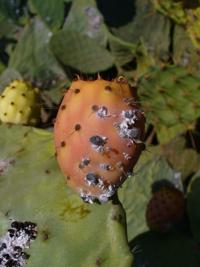
Cochineal scale insects suck sap from prickly pear cacti, and can reduce plant vigor.
Q: I have a backyard prickly pear with a cochineal infestation. Does that need to be treated? Do these guys ever go away on their own? Are they even actually a problem for the cactus?
A: Cochineal scale insects (Dactylopius species) suck sap from prickly pear cacti and large populations can reduce the vigor of the plants. Treating them is optional. They are noticeable due to the cottony wax the females generate to shelter themselves and their egg masses and this waxy material protects them from the environment and insecticides to some degree. The eggs hatch into nymphs (called crawlers) that feed for about three weeks before settling and becoming immobile. The crawler stage is when they spread their population on cactus plants. Once settled, they produce the waxy material that shelters them from predators and the weather. Multiple generations are produced each year. While these insects utilize the plant for food, the damage is usually negligible. If a plant is seriously colonized and showing signs of decline, you can prune off the worst pads and discard them (always prune at the joints). Blast the remaining portion of the plant with a high-pressure hose. This should expose and weaken the insects. Then spray the exposed scale with an insecticidal soap or horticultural oil. These low toxicity insecticides will minimize harmful effects on beneficial insects. Treating them is best done when the crawlers are active since they are the weakest link in their life cycle. This often occurs in the late winter or early spring for the first generation of the year.



